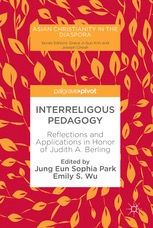interreligious pedagogy
Select an item by clicking its checkbox

Interreligious Pedagogy: Reflections and Applications in Honor of Judith A. Berling
Date Reviewed: January 17, 2019
In 2016, former students of Judith A. Berling, renowned for her interreligious pedagogy, held a symposium in honour of her retirement from the Graduate Theological Union in Berkeley, California. This collection of essays is the result. Readers looking for an introduction to Berling’s pedagogy are advised to consult Berling’s seminal work, Understanding Other Religious Worlds: A Guide to Interreligious Education (Orbis, 2004) – affectionately referred to by her students as the “Purple Book.” In this volume, readers will find a wide-ranging set of contexts within which Berling’s students have creatively applied and extended Berling’s method, especially her five “threads” of theological learning.
The seven essays are introduced by the editors and bookended by a preface and concluding reflections by Berling. In her reflections, Berling discusses the essays in an order that may be a more productive way of reading them: chapters 5 and 2 (issues in teaching today’s undergraduates); 7 and 4 (extending her pedagogy beyond the religion or theology classroom); 6 and 3 (attending to the social process of ‘othering’); and 8 (a meta-reflection on conceptual frames and assumptions). Preceding each essay, oddly for a book, is an abstract and list of key words. A remnant of the editing process seems to appear in the last paragraph on page 73.
While very diverse, the essays all attend to the importance of negotiating differences and crossing boundaries. Examples from the specific pedagogical experiences of the writers abound; while most deal with theology and religion, particularly within an Asian context and usually from a Christian setting, some essays boldly address the non-religious and secular, or areas outside the discipline of religious studies such as health sciences. The writers also demonstrate Berling’s emphasis on student-centred and collaborative learning, and the importance of the teacher “getting out of the way” (see Berling’s influential essay by the same title in Teaching Theology and Religion 1.1 [1998] 31-35).
A number of essays stand out. Emily Wu (chapter 4) shows that gathering oral histories can paradoxically silence voices, and advocates a stance of “cultural humility” rather than aspiring to “cultural competence.” Elizabeth Gordon (chapter 7) suggests “spirituality” and “wisdom sharing,” instead of “religion” and “interreligious dialog,” as mediating language to include the secular in articulating traditions of human flourishing. Joanne Doi (chapter 6) creatively demonstrates the pedagogical value of pilgrimage (in this case to the second World War site of a Japanese concentration camp in the United States).
Berling underlines the urgency of the pedagogical task outlined in this book: “Understanding and negotiating difference, creating conversations and relationships across boundaries of difference, is one of the most important challenges in our diverse world” (130). Her students have bountifully indicated how they have each manifested this urgent task in their varied careers due to Berling’s profound influence. “Berling’s vocation, teaching, and scholarship have had a ripple effect in widening circles, indeed building the foundations of cross-cultural and intercultural understanding” (87).